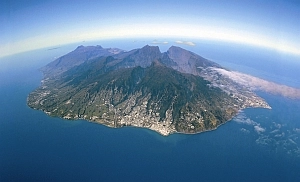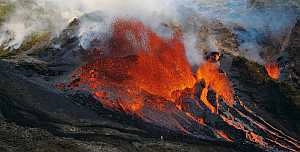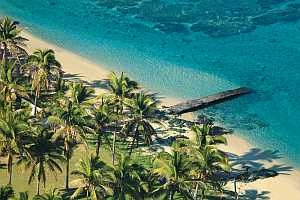Reunion - an island paradise for the whole family. Relaxation or adventure holiday (from surfing, scuba diving, hiking, abseiling, canyoning, windsurfing, parasailing and a volcanologists' dream).

By bringing together the greatest diversity of landscapes and cultures, this is the only destination that offers the most unforgettable experiences in just one trip.
Across a surface area of only 2500km², Reunion boasts a stunning array of untamed natural habitats and authentic cultures. With 40% of the island classified at a Unesco World Heritage site an impossible dream is suddenly made possible: to see the best of the world in just a few days.
During your very first few minutes here, you will already experience the variety of the different cultures living on the island in perfect harmony; from Asian cuisine to Creole marketplaces, along with Buddhist, Tamil or Christian traditions.
In just a few hours, you will be able to go from the vast and desert like lunar landscapes of the volcano to the lagoon in Ermitage. And then from the blue of the lagoon to the lush greens of the breathtaking mountain cirques.
In just a few days, you will have experienced such an exceptional variety of places and emotions, thanks to one unique island: Reunion Island.
An Island born 3 million years ago
Reunion is one of the youngest islands in the world. It first broke the surface area of the Indian Ocean less than three million years ago, and still has highly mountainous terrain with continued volcanic activity today.
With the combined strength of the ocean, the air and the movements of the earth's crust, an island of astonishing scenery Has Risen from the sea. We are left with the three Enormous 'cirques' (natural amphitheatres) of Cilaos, Salazie and Mafate, the deep valleys hewn into the volcanic slopes by the island's main rivers, and the upper plains dotted with peaks.
Due to its’ relatively reduced surface area (2,500 km²), Reunion’s steep mountains give a truly single geographical identity. The flight across the island, either by helicopter or by microlite, is simply breath-taking.
 The island's Highest point is the Piton des Neiges at 3070 m. Its last volcanic eruptions were 16,000 years ago. You can reach it from Either Cilaos, Salazie gold from La Plaine Kaffirs, and generally people climb it in two stages, staying one night at the Piton des Neiges accommodation before watching the sun rise from the summit over the Reunion next morning.
The island's Highest point is the Piton des Neiges at 3070 m. Its last volcanic eruptions were 16,000 years ago. You can reach it from Either Cilaos, Salazie gold from La Plaine Kaffirs, and generally people climb it in two stages, staying one night at the Piton des Neiges accommodation before watching the sun rise from the summit over the Reunion next morning.
Its younger counterpart, the Piton de la Fournaise (2632 m), appeared 300,000 years ago, and is one of the most active volcanoes in the world. Because it is what they call an "effusive" volcano, its’ eruptions remain relatively safe. Around twice a year, the people of Reunion are treated to a magical display of light, with fountains of lava gushing skywards and burning rivers flowing down the hillsides. Even while respecting distances of security, you can actually get quite close up without being at risk.
Sometimes, these lava flows reach the sea, creating enormous clouds of steam and even redefining the island's coastline. Lava from the furnace rarely comes close to any residential areas, and highly sensitive captors at the Volcano Observatory warn of any impending eruptions in good time.
 The coastline is made up, mainly, of rocky cliffs and beaches eroded by the waves. There is a total of 35 km of sandy beaches running from the west to the south of the island. Places: such as Grand Anse, St. Pierre, Saint-Leu Saint-Gilles (La Saline, Hermitage) all benefit from coral barriers forming shallow lagoons.
The coastline is made up, mainly, of rocky cliffs and beaches eroded by the waves. There is a total of 35 km of sandy beaches running from the west to the south of the island. Places: such as Grand Anse, St. Pierre, Saint-Leu Saint-Gilles (La Saline, Hermitage) all benefit from coral barriers forming shallow lagoons.
Across a surface area of only 2500km², Reunion boasts a stunning array of untamed natural habitats and authentic cultures. With 40% of the island classified at a Unesco World Heritage site an impossible dream is suddenly made possible: to see the best of the world in just a few days.
During your very first few minutes here, you will already experience the variety of the different cultures living on the island in perfect harmony; from Asian cuisine to Creole marketplaces, along with Buddhist, Tamil or Christian traditions.
In just a few hours, you will be able to go from the vast and desert like lunar landscapes of the volcano to the lagoon in Ermitage. And then from the blue of the lagoon to the lush greens of the breathtaking mountain cirques.
In just a few days, you will have experienced such an exceptional variety of places and emotions, thanks to one unique island: Reunion Island.
An Island born 3 million years ago
Reunion is one of the youngest islands in the world. It first broke the surface area of the Indian Ocean less than three million years ago, and still has highly mountainous terrain with continued volcanic activity today.
With the combined strength of the ocean, the air and the movements of the earth's crust, an island of astonishing scenery Has Risen from the sea. We are left with the three Enormous 'cirques' (natural amphitheatres) of Cilaos, Salazie and Mafate, the deep valleys hewn into the volcanic slopes by the island's main rivers, and the upper plains dotted with peaks.
Due to its’ relatively reduced surface area (2,500 km²), Reunion’s steep mountains give a truly single geographical identity. The flight across the island, either by helicopter or by microlite, is simply breath-taking.
 The island's Highest point is the Piton des Neiges at 3070 m. Its last volcanic eruptions were 16,000 years ago. You can reach it from Either Cilaos, Salazie gold from La Plaine Kaffirs, and generally people climb it in two stages, staying one night at the Piton des Neiges accommodation before watching the sun rise from the summit over the Reunion next morning.
The island's Highest point is the Piton des Neiges at 3070 m. Its last volcanic eruptions were 16,000 years ago. You can reach it from Either Cilaos, Salazie gold from La Plaine Kaffirs, and generally people climb it in two stages, staying one night at the Piton des Neiges accommodation before watching the sun rise from the summit over the Reunion next morning.Its younger counterpart, the Piton de la Fournaise (2632 m), appeared 300,000 years ago, and is one of the most active volcanoes in the world. Because it is what they call an "effusive" volcano, its’ eruptions remain relatively safe. Around twice a year, the people of Reunion are treated to a magical display of light, with fountains of lava gushing skywards and burning rivers flowing down the hillsides. Even while respecting distances of security, you can actually get quite close up without being at risk.
Sometimes, these lava flows reach the sea, creating enormous clouds of steam and even redefining the island's coastline. Lava from the furnace rarely comes close to any residential areas, and highly sensitive captors at the Volcano Observatory warn of any impending eruptions in good time.
 The coastline is made up, mainly, of rocky cliffs and beaches eroded by the waves. There is a total of 35 km of sandy beaches running from the west to the south of the island. Places: such as Grand Anse, St. Pierre, Saint-Leu Saint-Gilles (La Saline, Hermitage) all benefit from coral barriers forming shallow lagoons.
The coastline is made up, mainly, of rocky cliffs and beaches eroded by the waves. There is a total of 35 km of sandy beaches running from the west to the south of the island. Places: such as Grand Anse, St. Pierre, Saint-Leu Saint-Gilles (La Saline, Hermitage) all benefit from coral barriers forming shallow lagoons.Summer all year round
Reunion benefits from a tropical climate softened by the breezes of the Indian Ocean. The sun shines down all year round, especially in the north, west and south of the island. The wide variety of micro-climates in Reunion mean that one can be soaking up the sunshine by the sea in the morning and be enjoying the cool mountain air in the afternoon, and all this without having to travel far.
The year is divided up into two long periods: the warm and humid season, from November to April, and the fresher and drier season which runs from May to October.
The Austral Summer
The Austral summer reaches its peak in January and February, with daily temperatures well over 30° at the coast. Rain showers come in short, heavy patches. This is also the season for tropical cyclones, which occur on average once or twice a year and last generally a few days. This time of year is when the lush vegetation and cascading waterfalls are at their most impressive.
The Austral Winter
The temperatures are slightly fresher (around 24-25°) during winter-however, even at night at the coldest time, the coastal temperatures rarely drop lower than 20 degrees! The water temperature in the lagoon varies around 22°.
Apart from one or two exceptions, the trees do not lose their leaves and plant species tend to flower at different periods throughout the year.
Please note however, that if you're heading up into the mountains: the drop in temperature can come as a shock.
The eastern slopes of Reunion get the most rainfall, whereas the west coast is much drier.
Book your This email address is being protected from spambots. You need JavaScript enabled to view it. now.
The year is divided up into two long periods: the warm and humid season, from November to April, and the fresher and drier season which runs from May to October.
The Austral Summer
The Austral summer reaches its peak in January and February, with daily temperatures well over 30° at the coast. Rain showers come in short, heavy patches. This is also the season for tropical cyclones, which occur on average once or twice a year and last generally a few days. This time of year is when the lush vegetation and cascading waterfalls are at their most impressive.
The Austral Winter
The temperatures are slightly fresher (around 24-25°) during winter-however, even at night at the coldest time, the coastal temperatures rarely drop lower than 20 degrees! The water temperature in the lagoon varies around 22°.
Apart from one or two exceptions, the trees do not lose their leaves and plant species tend to flower at different periods throughout the year.
Please note however, that if you're heading up into the mountains: the drop in temperature can come as a shock.
The eastern slopes of Reunion get the most rainfall, whereas the west coast is much drier.
Book your This email address is being protected from spambots. You need JavaScript enabled to view it. now.
